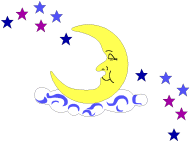

BruceMuseum.com
Greenwich, CT 06830 (203) 869-6786, Ext. 338
Astronomical Society of Greenwich info
 |
The Astronomical Society of Greenwich |  BruceMuseum.com |
| The
Bruce Museum, Museum
Drive Greenwich, CT 06830 (203) 869-6786, Ext. 338 Astronomical Society of Greenwich info |
Astronomical Society of Greenwich
Bruce Museum of Arts & Science
One Museum Drive
Greenwich, CT 06830
(203) 869-6786, Ext. 338
http://www.geocities.com/astrogreenwich
April 2000
Monthly Meeting
Wednesday, April 12 - Bruce Museum ? 7:30 PM
"The Creation of the Universe"
Come and enjoy this beautiful PBS video narrated by Timothy Ferris and featuring Stephen Hawking, Murray Gell-Mann, and Steven Weinberg. Afterwards, we can discuss what's changed in astronomy since this film was made in 1985!
Bowman Observatory Public Nights
(Weather Permitting)
April 11 & 25 ? 8-10 PM
May 9 & 23 ? 8:30-10:30 PM
June 13 & 27 ? 9-11 PM

2 - Moon in conjunction with Mercury
3 - Moon in conjunction with Venus
4 - New Moon
6 - Moon in conjunction with Mars, Jupiter, and Saturn
8 - Moon is at perigee (228,825 miles from Earth)
11 - First quarter Moon
18 - Full moon - "Egg Moon" determines the date of Easter and Passover
24 - Moon is at apogee (251,381 miles from Earth)
25 - Last quarter Moon in conjunction with Neptune
27 - Moon in conjunction with Uranus
Daylight Saving Time begins on the night of April 1-2. Set your clocks ahead one hour ? and come to Observatory an hour later.
Lyrid Meteor Shower peaks on the morning of April 21. Look at the constellation Lyra (east-south-east) after midnight for 10-100 meteors per hour. (Unfortunately, the waning Moon will probably interfere this year.)
Asteroid Ceres, a binocular object, can be found just east of the constellation Leo throughout the month. Move eastward from the star Denebola (the bright one at the extreme eastern end of the constellation) to find this mag. 7 object, the largest of the asteroids. Watch it for several nights to see how it moves along the background of faint stars in this region.
On the evening of April 6, watch a conjunction of Mars, Jupiter, and Saturn with the crescent Moon (see "Lunacy," above). This is the last chance to see these three outer planets before they disappear into the evening twilight. Be out there early; they'll all have set by 9:40 PM EDT.
Then, get up early on the morning of the 28th to see a conjunction of Mercury and Venus ? both rise at about 5:15 AM.
News Notes
For those of you who are online and haven't discovered it yet, NASA's web site features new articles (with beautiful photos, graphs, and diagrams) every few days. Just go to http://science.nasa.gov/headlines and sign up, and they'll e-mail you their latest releases free of charge. For those who aren't online, I'll be printing out anything that looks interesting. There's too much to mail on a regular basis, but I'll display them at monthly meetings and make photocopies for anyone who wants them.
Mark Your Calendar
Our May Meeting (Wednesday, May 3) will feature a special treat. ASG member Cathie Bischoff, who teaches science at Convent of the Sacred Heart, had a small and select high-school astronomy class this semester. Her four students will present their class projects to us.
Sunday, November 5 is also a date to set aside. The Bruce Museum is sponsoring a free lecture, "Explaining the Elegant Universe," by Dr. Brian Greene. Dr. Greene, a physicist, teaches at Columbia University and is the author of The Elegant Universe, an exposition of his revolutionary "string theory" of space, time, and matter. This talk will take place at 3 PM at Greenwich Academy and is expected to be very popular, so RSVP soon to: (203) 869-6786, Ext.420.
The Millennium, One More Time!
In response to last month's newsletter, Ken Greenberg writes:
"The whole flap over whether the millennium ended last December or will end this December stems from the supposition that every century must have 100 years and every millennium 1000. Because the first year was "1" in our current numbering system, logically the second millennium began in 1001, and the third will start in 2001.
"However, this ignores the fact that calendars are, to a certain extent, arbitrary. The common numbering system supposedly dating from the birth of Jesus was not implemented until the first millennium?. This calendar is also erroneous and it is now believed that Jesus was born in 3 or 4 BCE."
Ken goes on to point out that for if we're going to insist that millennium last exactly a thousand years, they logically ought to be a thousand full years; i.e., all the years in it should be 365 or 366 days long. Yet we know that Pope Gregory XIII knocked 10 days out of the calendar to correct the problem created by a few too many leap years in the previous centuries. He concludes that, "if Pope Gregory could make 1582 a 356-day year to correct an error, I see no reason why, by popular consent, we cannot correct for the Venerable Bede's neglecting to have a year Zero by having a 999-year millennium ending December 31, 2000" ? especially since everyone's celebrated the millennium already!
Frank Morehouse added to his original comments by reminding us that the year 2000 is special in one way ? it's the first century year in 400 years to be a leap year. As everyone will recall, as part of the Gregorian correction, years ending in "00" are not leap years unless they're exactly divisible by 400.
And, speaking of the calendar?
In case you're wondering why Easter is so late this year, the answer lies in last month's Full Moon, which occurred at 11:44 PM EST on March 19 ? less than three hours before the Vernal Equinox which took place at 2:35 AM on the 20th. Lucky for us those times weren't reversed. Since in the Western Christian churches Easter occurs on the first Sunday after the first full Moon of spring, we would have had a very early and probably cold one!
Passover takes place on the 14th night of Nisan, the first lunar month of spring. This is almost always the night of the full Moon, since in the Jewish calendar the lunar month begins at sundown on the evening the crescent Moon first appears. That's why Passover usually coincides, more or less, with Easter. However, because 12 lunar months is 10 to 11 days shorter than a solar year, Nisan tends to slide backwards into winter. Every two or three years the Jewish calendar must be corrected by adding a thirteenth month (which is like having February twice in the secular calendar) to push Passover back after the Equinox where it belongs.
This back-and-forth slide ? and occasional divergence with Easter - can be seen in the dates for the past ten years:
Year Full Moon Passover Easter
1991 March 30 March 30 March 31
1992 April 16 April 18 April 19
1993 April 6 April 6 April 11
1994 March 27 March 27 April 3
1995 April 15 April 15 April 16
1996 April 3 April 4 April 7
1997 March 23 April 22 March 30
1998 April 11 April 11 April 12
1999 March 31 March 31 April 4
2000 April 18 April 19 April 23
Obviously, not throwing in that extra winter month in 1992, 1995, 1997, and 2000 would have put Passover before the Equinox. 1997 also illustrates how it can get out of sync with Easter when the Jewish calendar is corrected in the same year that the full Moon is early.
Eastern Orthodox Easter, incidentally, is celebrated on the Sunday after Passover ends ? so this year it's on April 30. Perhaps we in the West should adopt this system, to have a better chance of good weather ? not to mention more spring flowers!
Anyway?whatever and whenever you're celebrating, have a happy Spring!